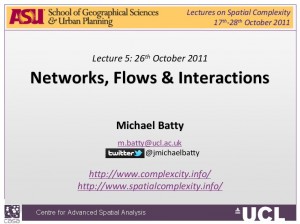The fifth lecture introduces complexity from the viewpoint of interactions. We define networks and flows as two side of the same coin. We first present the notion of graphs where the size of the hubs relates to their connectivity or accessibility and then weighted links in such graphs as flows. We then present a rather discursive and visual presentation of networks and flows in history showing that these ideas go back a long way and this then suggests the power of visualisation dealing with complexity. We then define how a network evolves showing that as we add one link at a time to an undirected symmetric graph. The average path length falls as we add links but quite suddenly at around one third of all possible links the graph is strongly connected where we can get from any one node to another and the path length does not drop much after this. This is a phase transition. We then look at small worlds and random graphs and then reintroduce our preferential attachment example of growing a network showing how the volumes or the connectivity of the hubs scale more or less according to a power law. We then link the lecture to our work on theLondonrail transport system showing that this is scaling in terms of its hub volumes.
Here is the lecture. Click on the Full-text PDF size: 722 Kb or on the adjacent image. The lecture was first given on Wednesday 26th October and posted the next day. Its hard work bashing these lectures up from scratch even though I have some of the material already, while also trying to do other things.The Bibliography page hasn’t yet been updated but will be and probably at this rate after the course has ended









